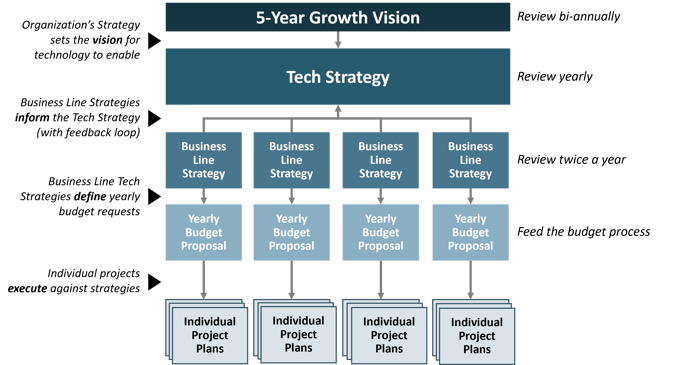The financial institution had strong community networks but needed to better leverage digital platforms to capture new customers and scale existing operations. Their challenges were multi-faceted: internal processes were highly manual, integrations between systems were uncommon, and technology projects were poorly defined and rarely on schedule or within scope.
An assessment of existing systems and projects revealed that technology challenges stemmed from ineffective project planning and prioritization, unclear technology ownership, and poor data competency. With new investments flooding in, the organization needed to quickly learn how to scale and leverage technology to grow.
WP&C worked closely with the organization to develop new capabilities and competencies for future technology-enabled growth. We developed a fit-for-purpose technology strategy that aligned with the current business strategy and could be revised as the business vision evolved. The focus was as much on people and processes as it was on technology. WP&C worked with the client in an iterative and experimental manner to:
- Partner: Collaborate with the organization to:
• Understand their 5-year growth vision, current pain points, and current technology
• Define a target technology vision to enable the growth vision
• Develop a technology strategy to deliver on the technology vision
• Align and socialize the technology strategy across both business and technology leadership
- Pilot: Utilize a critical system replacement project to pioneer the use of new tools and processes that enable the organization to execute and evolve the technology strategy
- Perfect: Rapidly learn from the pilot project and evolve the approach, tools, and processes to incorporate those learnings
- Promote: Institutionalize learnings from the pilot project to enable adoption and standardization of those learnings across the entire organization

With an iterative and practical approach, WP&C was able to deliver a key technology project while developing and refining tools for the organization—ensuring they were fit-for-purpose.
- Develop an ownership and governance model to ensure the technology strategy remains relevant and spurs future strategic discussions
- Align technology strategy with budgeting and planning processes to drive prioritization and resolve conflicts over internal resources
- Refine and optimize internal processes before leveraging automation to ensure the least complex solution
- Invest in upfront project preparation—capture requirements, align stakeholders, and understand how the solution fits in the architecture before considering vendors
- Take a data-first approach and consider data and integration strategies before selecting technology solutions—ensuring maximum value-add
- Develop a Risk Management Framework for technology projects and programs

The technology strategy must be aligned to the organization’s growth vision, individual business lines’ goals, and the budget process.
The technology strategy was developed and communicated in just four weeks—an effort the organization struggled to accomplish over previous years. With the strategy in place, the focus quickly shifted to enablement as supporting processes, tools, and governance were developed.
The technology strategy work also enabled strategic conversations between business leaders and IT—empowering business lines to better align their technology projects with the company’s broader technology vision and strategy. This new alignment ensured the right stakeholders were involved in project decisions early and provided more leverage across the organization, leading to quicker project deployments, better clarity on impacted internal resources, and faster consensus on how projects aligned with desired business outcomes.
WP&C co-managed the pilot project execution, which required rapidly selecting a replacement solution for a critical core business system that would no longer be supported by the vendor. A more modern technology solution was identified, assessed, agreed, and approved in 90 days (half the typical time), and the successful implementation ensured business continuity following the unplanned vendor sunset.


